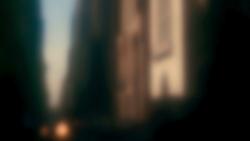A&E
Bill Jacobson discusses his perspective on photography
By Elizabeth Lvov ’17
March 6, 2015
The idea of a photograph, Bill Jacobson told us as he sat casually behind the podium in KJ Auditorium, is that it is simultaneously eternal and temporary; a moment, captured forever, but already passed within seconds of the photograph being taken. Strangely enough, he started his post-graduate career as a photographer featured in places like the Guggenheim with a seven year period in which he collected old photographs rather than take them himself. On the screen, he showed us strange black and white pictures which ranged from dark landscapes to bizarre portraits of serious-faced people, sometimes layered with accidental double exposure or other tricks of the film.
When Jacobson started taking photographs himself, his trademark style was very clearly established in an out of focus black and white blur. His first series of photographs, titled “Interim Landscapes,” was not necessarily focused on landscapes as implied by the title, but rather composed of a subtle interaction of places clearly identifiable even in their indistinct lines, and the forms of people utterly unrecognizable with their vague faces. The influence of Jacobson’s initial collecting of photographs is evident in that the landscapes evoke the style of older photography, playing on the themes of temporality and eternity that Jacobson himself introduced.
The next series he worked on, and probably his best, is titled simply “Interim Portraits.” Taken at the height of the AIDS epidemic, the series is evocative and unexpectedly moving, a soft-focus tribute to people whose precise facial features still portray their intense emotion despite the inherent vagueness of the medium. The next few series, including (in order) “Interim Figures/Interim Couples,” “Songs of Sentient Beings” and
“Thought Series/History Series,” continue with this theme of out-of-focus focus on figures and faces, sometimes in interaction with each other, sometimes in isolation, always the blurred focal point on a monochromatic background.
The series which follows, “Untitled,” is a sudden jolt in that the pictures are still blurred, but now in color, of the distinctive New York City streets so idiosyncratic despite the haze. Jacobson recounted to us how going to India and seeing all of the colors inspired him to see his city in a new light. His New Years Day series is another love letter to New York, meant to capture the particular calm of New Years Day despite the fact that none of the pictures are taken on New Years Day. The series progress one after the other, becoming simultaneously more and less abstract as the focus becomes crystal clear but the subject matter becomes a mix of canvases and objects in a bizarre mixing of media.
While Jacobson started off his presentation fairly mechanically reading off of a page, as he began to speak of the specifics of his work he visibly relaxed and set aside his prompts to speak with a quiet sort of candor. The presentation of photographs as a slideshow was slightly jarring; one is accustomed to perusing photographs at one’s leisure, be it in the form of a casual stroll through a gallery or scrolling online. To be guided by the photographer himself at an unpredictable cadence is strange; there were moments when he would linger to elaborate on a seemingly accidental blur of motion, and other moments when he would flick by interesting compositions of entwined limbs or bustling city streets with barely a pause. Overall, it was interesting to have such an intimate look into his work, and Jacobson’s candor and talent compensated for his rather dry presentation.





